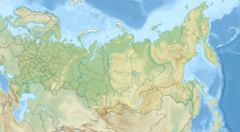Аркаим (in Russian) | |
 Aerial view of the main citadel | |
| Location | Bredinsky District, Chelyabinsk Oblast, Russia |
|---|---|
| Region | Kazakh Steppe |
| Coordinates | 52°38′57.34″N 59°34′17.194″E / 52.6492611°N 59.57144278°E |
| Type | Settlement |
| Area | 2 ha (4.9 acres) |
| History | |
| Periods | Late Middle Bronze Age |
| Cultures | Sintashta culture |
| Site notes | |
| Archaeologists | Gennady Zdanovich |
| Ownership | Public |
| Public access | Yes |
| Part of a series on |
| Indo-European topics |
|---|
 |
Arkaim (Russian: Аркаим) is a fortified archaeological site, dated to c. 2150-1650 BCE,[1] belonging to the Sintashta culture, situated in the steppe of the Southern Urals, 8.2 km (5.10 mi) north-northwest of the village of Amursky and 2.3 km (1.43 mi) east-southeast of the village of Alexandrovsky in the Chelyabinsk Oblast of Russia, just north of the border with Kazakhstan.[2] It was discovered in 1987 by a team of archaeologists which later came under the leadership of Gennady Zdanovich. The realization of its importance unprecedentedly forestalled the planned flooding of the area for a reservoir.[3] The construction of Arkaim is attributed to the early Proto-Indo-Iranian-speakers of the Sintashta culture, which some scholars believe represents the proto-Indo-Iranians before their split into different groups and migration to Central Asia and from there to the Iranian plateau, Indian subcontinent and other parts of Eurasia.[4]
- ^ Ural Federal University, (August 16, 2021). "Legendary Arkaim, Sintashta, Emder - discoveries of our archaeologists": "...The fortified settlement of Arkaim relating to the 22nd-17th centuries B.C. is perhaps the most famous archeological monument among the so-called "Country of Cities", a "necklace" of ancient settlements on the territory of the South Urals..."
- ^ Koryakova, Ludmila; Kohl, Philip L. (2000). "Complex Societies of Central Eurasia from the 3d to the 1st Millennia b.c.: Regional Specifics in the Light of Global Models". Current Anthropology. 41 (4). University of Chicago Press: 638–642. doi:10.1086/317391. JSTOR 10.1086/317391. S2CID 146764291.
- ^ Shnirelman 1998, p. 33.
- ^ Shnirelman 1998, p. 35, The discovery in the southern Urals of a perfectly conserved city some 3,600 years old was not merely a significant archaeological event. As V. A. Shnirelman explains, it set off a chain reaction of far‐fetched speculation and extreme ethnic nationalism which sought to exploit the find for purely political purposes..

